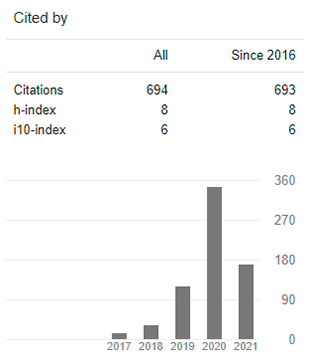Traditional Dance San Benito of Timotes, Heritage of Cultural Identity
DOI:
https://doi.org/10.29394/Scientific.issn.2542-2987.2019.4.11.13.260-278Keywords:
history, cultural heritage, identityAbstract
Traditional folk festivals are a characteristic feature of the Cultural Historical Heritage and therefore of the cultural identity of a town. They constitute an event of obligatory look in time, an integral vision as a catalyst for identity expressions. The present essay is addressed with the purpose of making known the patron saint festival of San Benito of Timotes as a historical legacy and cultural heritage of the Merida region, strengthening and refounding the Venezuelan tradition. The study was approached as reflexive critical field work of qualitative nature and bibliographic review to contrast and interpret realities. Referents studied that support the essay: Law of Protection and Defense of Cultural Heritage (1993) which establishes the preservation, defense and safeguarding of all works, groups and places created by man or of natural origin, that are in the territory of the Republic, and that for their cultural content constitute fundamental elements of our national identity. In the development of work, fundamental aspects such as cultural heritage, traditional festivals and the way of projecting culture are raised, as well as the elements that identify the San Benito dance and turn it into a reflection of cultural identity for future generations.
Downloads
References
Bonfil, G. (1997). Nuestro patrimonio cultural: un laberinto de significados. El Patrimonio Cultural de México. Tomo I. México: Consejo Nacional para la Cultura y las Artes-Fondo de Cultura Económica, pág. 29.
Boas, F. (1964). Cuestiones fundamentales de Antropología Cultural. Buenos Aires, Argentina: Ediciones Solar-Hachette S.A., pág. 167.
Espinoza, J. (1992). Historia Mínima de Timotes. Venezuela: I Edición. Centro Editorial de la Escuela de Comunicadores Populares “Mario Keplun”.
Espinoza, J. (2008). Timotes Paraíso de los Andes. Venezuela: Guía Turística. Impresión Talleres Universo Grafico C.A.
Heinze, T. (2010). Respuestas a mis Amigos Católicos. California, EE.UU.: Edición Kindle, Chick Publications.
Ley de Protección y Defensa del Patrimonio Cultural (1993). Titulo I. Del Patrimonio Cultural, Capítulo I, Disposiciones Generales, Art. 1 y 2. Gaceta Oficial de la República de Venezuela, Numero 4.623 Extraordinario del viernes 3 de octubre. Caracas, Venezuela: El Congreso de la República de Venezuela.
Martínez, C. (2018). Participación Comunitaria Orientada hacia la Valoración del Patrimonio Cultural. Revista Scientific, 3(8), 290-300. Recuperado de: https://doi.org/10.29394/Scientific.issn.2542-2987.2018.3.8.15.290-300
Rodríguez, S. (2000). Religión y fiesta. Antropología de las creencias y rituales de Andalucía. Sevilla, España: Signatura Demos.
UNESCO (2011). Año Internacional de los Afrodescendientes. Madrid, España: Folleto Inmaterial OEI, 2021, Metas Educativas.
Published
How to Cite
Issue
Section
License
Copyright (c) 2019 INDTEC, C.A.

This work is licensed under a Creative Commons Attribution-NonCommercial-ShareAlike 4.0 International License.
The content of the journals of this site, are under a Creative Commons Attribution-Noncommercial-Share Alike 4.0 International License.













